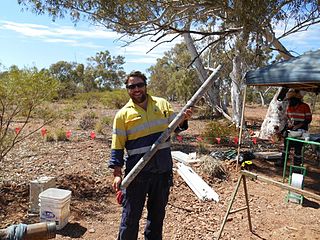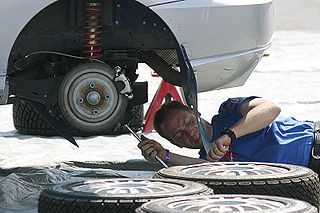Related Research Articles

Geotechnical engineering, also known as geotechnics, is the application of scientific methods and engineering principles to the acquisition, interpretation, and use of knowledge of materials of the Earth's crust and earth materials for the solution of engineering problems and the design of engineering works. It is the applied science of predicting the behavior of the Earth, its various materials and processes towards making the Earth more suitable for human activities and development.

A trench is a type of excavation or depression in the ground that is generally deeper than it is wide, and narrow compared with its length.

A sanitary sewer or foul sewer is an underground pipe or tunnel system for transporting sewage from houses and commercial buildings to treatment facilities or disposal. Sanitary sewers are part of an overall system called a sewage system or sewerage.

Retaining walls are relatively rigid walls used for supporting soil laterally so that it can be retained at different levels on the two sides. Retaining walls are structures designed to restrain soil to a slope that it would not naturally keep to. They are used to bound soils between two different elevations often in areas of terrain possessing undesirable slopes or in areas where the landscape needs to be shaped severely and engineered for more specific purposes like hillside farming or roadway overpasses. A retaining wall that retains soil on the backside and water on the frontside is called a seawall or a bulkhead.

A French drain or weeping tile is a trench filled with gravel or rock or containing a perforated pipe that redirects surface water and groundwater away from an area. A French drain can have perforated hollow pipes along the bottom to quickly vent water that seeps down through the upper gravel or rock.

Engineering geology is the application of the geology to engineering study for the purpose of assuring that the geological factors regarding the location, design, construction, operation and maintenance of engineering works are recognized and accounted for. Engineering geologists provide geological and geotechnical recommendations, analysis, and design associated with human development and various types of structures. The realm of the engineering geologist is essentially in the area of earth-structure interactions, or investigation of how the earth or earth processes impact human made structures and human activities.

Dredging is the operation of excavating material from a water environment for the purpose of improving existing water features; reshaping land and water features to alter drainage, navigability, and commercial use; construct dams, dikes, and other controls for streams and shorelines; and to recover valuable mineral deposits or marine life having commercial value. In all but a few situations the excavation is undertaken by a specialist floating plant, known as a dredger. Dredging is carried out in many different locations and for many different purposes, but the main objectives are usually to recover material of value or use, or to create a greater depth of water. All dredges can generally be classified as suction or mechanical.

In geotechnical engineering, a caisson is a watertight retaining structure used, for example, to work on the foundations of a bridge pier, for the construction of a concrete dam, or for the repair of ships. Caissons are constructed in such a way that the water can be pumped out, keeping the work environment dry. When piers are being built using an open caisson, and it is not practical to reach suitable soil, friction pilings may be driven to form a suitable sub-foundation. These piles are connected by a foundation pad upon which the column pier is erected.

Bioswales are linear channels designed to concentrate and convey stormwater runoff while removing debris and pollution. Bioswales can also be beneficial in recharging groundwater.

An auto mechanic is a tradesperson and mechanic with a variety of automobile makes or either in a specific area or in a specific make of automobile. In repairing cars, their main role is to diagnose the problem accurately and quickly. They often have to quote prices for their customers before commencing work or after partial disassembly for inspection. Their job may involve the repair of a specific part or the replacement of one or more parts as assemblies.

Surface runoff is the flow of water that occurs when excess stormwater, meltwater, or other sources flow over the Earth's surface. This can occur when the soil is saturated to full capacity, and rain arrives more quickly than soil can absorb it. Surface runoff often occurs because impervious areas do not allow water to soak into the ground. Surface runoff is a major component of the water cycle. It is the primary agent of soil erosion by water. The land area producing runoff that drains to a common point is called a drainage basin.

A silt fence, sometimes (misleadingly) called a "filter fence," is a temporary sediment control device used on construction sites to protect water quality in nearby streams, rivers, lakes and seas from sediment in stormwater runoff. Silt fences are widely used on construction sites in North America and elsewhere, due to their low cost and simple design. However, their effectiveness in controlling sediment can be limited, due to problems with poor installation, proper placement, and/or inadequate maintenance.

Bridge scour is the removal of sediment such as sand and gravel from around bridge abutments or piers. Scour, caused by swiftly moving water, can scoop out scour holes, compromising the integrity of a structure.

A check dam is a small, sometimes temporary, dam constructed across a swale, drainage ditch, or waterway to counteract erosion by reducing water flow velocity. Check dams themselves are not a type of new technology; rather, they are an ancient technique dating from the second century A.D. Check dams are typically, though not always, implemented in a system of several dams situated at regular intervals across the area of interest.
Dewatering is the removal of water from solid material or soil by wet classification, centrifugation, filtration, or similar solid-liquid separation processes, such as removal of residual liquid from a filter cake by a filter press as part of various industrial processes.
Soil and Water Bioengineering is a discipline of civil engineering. It pursues technological, ecological, economic as well as design goals and seeks to achieve these primarily by making use of living materials, i.e. seeds, plants, part of plants and plant communities, and employing them in near–natural constructions while exploiting the manifold abilities inherent in plants. Soil bioengineering may sometimes be a substitute for classical engineering works; however, in most cases it is a meaningful and necessary method of complementing the latter. Its application suggests itself in all fields of soil and hydraulic engineering, especially for slope and embankment stabilization and erosion control.

Living shorelines are a relatively new approach for addressing shoreline erosion and protecting marsh areas. Unlike traditional structures such as bulkheads or seawalls that worsen erosion, living shorelines incorporate as many natural elements as possible which create more effective buffers in absorbing wave energy and protecting against shoreline erosion. The process of creating a living shoreline is referred to as soft engineering, which utilizes techniques that incorporate ecological principles in shoreline stabilization. The natural materials used in the construction of living shorelines create and maintain valuable habitats. Structural and organic materials commonly used in the construction of living shorelines include sand, wetland plants, sand fill, oyster reefs, submerged aquatic vegetation, stones and coir fiber logs.
There are seven soil deposits in India. These soils are formed by the sediments brought down by the rivers. They are also rich in chemical ingredients.

Digging, also referred to as excavation, is the process of using some implement such as claws, hands, manual tools or heavy equipment, to remove material from a solid surface, usually soil or sand on the surface of the Earth. Digging is actually the combination of two processes, the first being the breaking or cutting of the surface, and the second being the removal and relocation of the material found there. In a simple digging situation, this may be accomplished in a single motion, with the digging implement being used to break the surface and immediately fling the material away from the hole or other structure being dug.
References
- 1 2 3 "Best Management Practices Manual" (PDF). Archived from the original (PDF) on 11 December 2014. Retrieved 13 September 2014.
- ↑ soil mechanics and foundation engineering by Dr. K.R.ARORA on page no. 391. Retrieved on 13 September 2014
- ↑ Soil Mechanics and Foundation Engineering by Dr. K.R.ARORA on page no. 392. Retrieved on 13 September 2014
- ↑ "Inteceptor ditches" . Retrieved 13 September 2014.